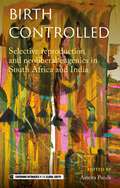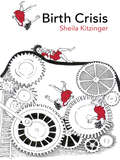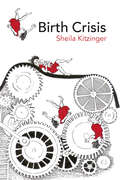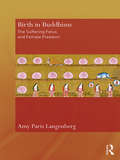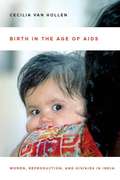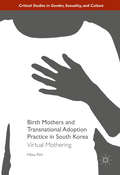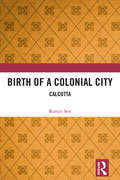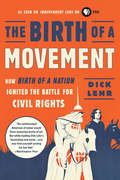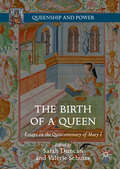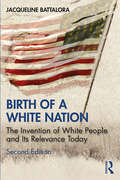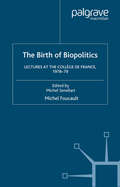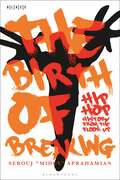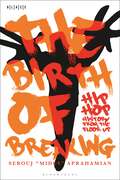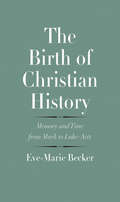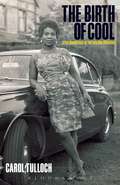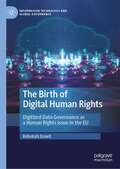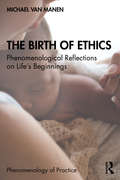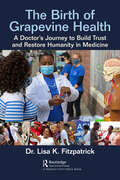- Table View
- List View
Birth controlled: Selective reproduction and neoliberal eugenics in South Africa and India (Governing Intimacies in the Global South)
by Amrita PandeBirth controlled analyses the world of selective reproduction – the politics of who gets to legitimately reproduce the future – through a cross-cultural analysis of three modes of ‘controlling’ birth: contraception, reproductive violence and repro-genetic technologies. It argues that as fertility rates decline worldwide, the fervour to control fertility, and fertile bodies, does not dissipate; what evolves is the preferred mode of control. Although new technologies like those that assist conception or allow genetic selection may appear to be an antithesis of other violent versions of population control, this book demonstrates that both are part of the same continuum. All population control policies target and vilify women (Black women in particular), and coerce them into subjecting their bodies to state and medical surveillance; Birth controlled argues that assisted reproductive technologies and repro-genetic technologies employ a similar and stratified burden of blame and responsibility based on gender, race, class and caste. To empirically and historically ground the analysis, the book includes contributions from two postcolonial nations, South Africa and India, examining interactions between the history of colonialism and the economics of neoliberal markets and their influence on the technologies and politics of selective reproduction.The book provides a critical, interdisciplinary and cutting-edge dialogue around the interconnected issues that shape reproductive politics in an ostensibly ‘post-population control’ era. The contributions draw on a breadth of disciplines ranging from gender studies, sociology, medical anthropology, politics and science and technology studies to theology, public health and epidemiology, facilitating an interdisciplinary dialogue around the interconnected modes of controlling birth and practices of neo-eugenics.
Birth controlled: Selective reproduction and neoliberal eugenics in South Africa and India (Governing Intimacies in the Global South)
by Amrita PandeBirth controlled analyses the world of selective reproduction – the politics of who gets to legitimately reproduce the future – through a cross-cultural analysis of three modes of ‘controlling’ birth: contraception, reproductive violence and repro-genetic technologies. It argues that as fertility rates decline worldwide, the fervour to control fertility, and fertile bodies, does not dissipate; what evolves is the preferred mode of control. Although new technologies like those that assist conception or allow genetic selection may appear to be an antithesis of other violent versions of population control, this book demonstrates that both are part of the same continuum. All population control policies target and vilify women (Black women in particular), and coerce them into subjecting their bodies to state and medical surveillance; Birth controlled argues that assisted reproductive technologies and repro-genetic technologies employ a similar and stratified burden of blame and responsibility based on gender, race, class and caste. To empirically and historically ground the analysis, the book includes contributions from two postcolonial nations, South Africa and India, examining interactions between the history of colonialism and the economics of neoliberal markets and their influence on the technologies and politics of selective reproduction.The book provides a critical, interdisciplinary and cutting-edge dialogue around the interconnected issues that shape reproductive politics in an ostensibly ‘post-population control’ era. The contributions draw on a breadth of disciplines ranging from gender studies, sociology, medical anthropology, politics and science and technology studies to theology, public health and epidemiology, facilitating an interdisciplinary dialogue around the interconnected modes of controlling birth and practices of neo-eugenics.
Birth Crisis
by Sheila KitzingerOne new mother in twenty is diagnosed with traumatic stress after childbirth. In Birth Crisis Sheila Kitzinger explores the disempowerment and anxiety experienced by these women. Key topics discussed include: increasing intervention in pregnancy the shift in emphasis from relationships to technology in childbirth how family, friends and professional caregivers can reach out to traumatized mothers how women can work through stress to understand themselves more deeply and grow in emotional maturity how care and the medical system needs to be changed. Birth Crisis draws on mothers' voices and real-life experiences to explore the suffering after childbirth which has, until now, been brushed under the carpet. It is a fascinating and useful resource for student and practising midwives, all health professionals, and women and their families who want to learn how to overcome a traumatic birth.
Birth Crisis
by Sheila KitzingerOne new mother in twenty is diagnosed with traumatic stress after childbirth. In Birth Crisis Sheila Kitzinger explores the disempowerment and anxiety experienced by these women. Key topics discussed include: increasing intervention in pregnancy the shift in emphasis from relationships to technology in childbirth how family, friends and professional caregivers can reach out to traumatized mothers how women can work through stress to understand themselves more deeply and grow in emotional maturity how care and the medical system needs to be changed. Birth Crisis draws on mothers' voices and real-life experiences to explore the suffering after childbirth which has, until now, been brushed under the carpet. It is a fascinating and useful resource for student and practising midwives, all health professionals, and women and their families who want to learn how to overcome a traumatic birth.
Birth in Buddhism: The Suffering Fetus and Female Freedom (Routledge Critical Studies in Buddhism)
by Amy Paris LangenbergRecent decades have seen a groundswell in the Buddhist world, a transnational agitation for better opportunities for Buddhist women. Many of the main players in the transnational nuns movement self-identify as feminists but other participants in this movement may not know or use the language of feminism. In fact, many ordained Buddhist women say they seek higher ordination so that they might be better Buddhist practitioners, not for the sake of gender equality. Eschewing the backward projection of secular liberal feminist categories, this book describes the basic features of the Buddhist discourse of the female body, held more or less in common across sectarian lines, and still pertinent to ordained Buddhist women today. The textual focus of the study is an early-first-millennium Sanskrit Buddhist work, "Descent into the Womb scripture" or Garbhāvakrānti-sūtra. Drawing out the implications of this text, the author offers innovative arguments about the significance of childbirth and fertility in Buddhism, namely that birth is a master metaphor in Indian Buddhism; that Buddhist gender constructions are centrally shaped by Buddhist birth discourse; and that, by undermining the religious importance of female fertility, the Buddhist construction of an inauspicious, chronically impure, and disgusting femininity constituted a portal to a new, liberated, feminine life for Buddhist monastic women. Thus, this study of the Buddhist discourse of birth is also a genealogy of gender in middle period Indian Buddhism. Offering a new critical perspective on the issues of gender, bodies and suffering, this book will be of interest to an interdisciplinary audience, including researchers in the field of Buddhism, South Asian history and religion, gender and religion, theory and method in the study of religion, and Buddhist medicine.
Birth in Buddhism: The Suffering Fetus and Female Freedom (Routledge Critical Studies in Buddhism)
by Amy Paris LangenbergRecent decades have seen a groundswell in the Buddhist world, a transnational agitation for better opportunities for Buddhist women. Many of the main players in the transnational nuns movement self-identify as feminists but other participants in this movement may not know or use the language of feminism. In fact, many ordained Buddhist women say they seek higher ordination so that they might be better Buddhist practitioners, not for the sake of gender equality. Eschewing the backward projection of secular liberal feminist categories, this book describes the basic features of the Buddhist discourse of the female body, held more or less in common across sectarian lines, and still pertinent to ordained Buddhist women today. The textual focus of the study is an early-first-millennium Sanskrit Buddhist work, "Descent into the Womb scripture" or Garbhāvakrānti-sūtra. Drawing out the implications of this text, the author offers innovative arguments about the significance of childbirth and fertility in Buddhism, namely that birth is a master metaphor in Indian Buddhism; that Buddhist gender constructions are centrally shaped by Buddhist birth discourse; and that, by undermining the religious importance of female fertility, the Buddhist construction of an inauspicious, chronically impure, and disgusting femininity constituted a portal to a new, liberated, feminine life for Buddhist monastic women. Thus, this study of the Buddhist discourse of birth is also a genealogy of gender in middle period Indian Buddhism. Offering a new critical perspective on the issues of gender, bodies and suffering, this book will be of interest to an interdisciplinary audience, including researchers in the field of Buddhism, South Asian history and religion, gender and religion, theory and method in the study of religion, and Buddhist medicine.
Birth in the Age of AIDS: Women, Reproduction, and HIV/AIDS in India
by Cecilia Van HollenBirth in the Age of AIDS is a vivid and poignant portrayal of the experiences of HIV-positive women in India during pregnancy, birth, and motherhood at the beginning of the 21st century. The government of India, together with global health organizations, established an important public health initiative to prevent HIV transmission from mother to child. While this program, which targets poor women attending public maternity hospitals, has improved health outcomes for infants, it has resulted in sometimes devastatingly negative consequences for poor, young mothers because these women are being tested for HIV in far greater numbers than their male spouses and are often blamed for bringing this highly stigmatized disease into the family. Based on research conducted by the author in India, this book chronicles the experiences of women from the point of their decisions about whether to accept HIV testing, through their decisions about whether or not to continue with the birth if they test HIV-positive, their birthing experiences in hospitals, decisions and practices surrounding breast-feeding vs. bottle-feeding, and their hopes and fears for the future of their children.
Birth Mothers and Transnational Adoption Practice in South Korea: Virtual Mothering (Critical Studies in Gender, Sexuality, and Culture)
by Hosu KimThis book illuminates the hidden history of South Korean birth mothers involved in the 60-year-long practice of transnational adoption. The author presents a performance-based ethnography of maternity homes, a television search show, an internet forum, and an oral history collection to develop the concept of virtual mothering, a theoretical framework in which the birth mothers' experiences of separating from, and then reconnecting with, the child, as well as their painful,ambivalent narratives of adoption losses, are rendered, felt and registered. In this, the author refuses a universal notion of motherhood. Her critique of transnational adoption and its relentless effects on birth mothers’ lives points to the everyday, normalized, gendered violence against working-class, poor, single mothers in South Korea’s modern nation-state development and illuminates the biopolitical functions of transnational adoption in managing an "excess" population. Simultaneously, her creative analysis reveals a counter-public, and counter-history, proposing the collective grievances of birth mothers.
Birth of a Colonial City: Calcutta
by Ranjit SenLong before Calcutta was ‘discovered’ by Job Charnock, it thrived by the Hugli since times immemorial. This book, and its companion Colonial Calcutta, is a biographical account of the when, the how and the what of a global city and its emergence under colonial rule in the 1800s. Ranjit Sen traces the story of how three clustered villages became the hub of the British Empire and a centre of colonial imagination. He examines the historical and geopolitical factors that were significant in securing its prominence, and its subsequent urbanization which was a colonial experience without an antecedent. Further, it sheds light on Calcutta’s early search for identity — how it superseded interior towns and flourished as the seat of power for its hinterland; developed its early institutions, while its municipal administration slowly burgeoned. A sharp analysis of the colonial enterprise, this volume lays bare the underbelly of the British Raj. It will be of great interest to scholars and researchers of modern history, South Asian history, urban studies, British Studies and area studies.
Birth of a Colonial City: Calcutta
by Ranjit SenLong before Calcutta was ‘discovered’ by Job Charnock, it thrived by the Hugli since times immemorial. This book, and its companion Colonial Calcutta, is a biographical account of the when, the how and the what of a global city and its emergence under colonial rule in the 1800s. Ranjit Sen traces the story of how three clustered villages became the hub of the British Empire and a centre of colonial imagination. He examines the historical and geopolitical factors that were significant in securing its prominence, and its subsequent urbanization which was a colonial experience without an antecedent. Further, it sheds light on Calcutta’s early search for identity — how it superseded interior towns and flourished as the seat of power for its hinterland; developed its early institutions, while its municipal administration slowly burgeoned. A sharp analysis of the colonial enterprise, this volume lays bare the underbelly of the British Raj. It will be of great interest to scholars and researchers of modern history, South Asian history, urban studies, British Studies and area studies.
The Birth of a Movement: How Birth of a Nation Ignited the Battle for Civil Rights
by Dick LehrAt the dawn of the modern civil rights movement, Monroe Trotter, a journalist agitator, and D.W. Griffith, a technically brilliant filmmaker, incited a public confrontation that roiled America, pitting black against white, Hollywood against Boston, and free speech against the fight for equality.Monroe Trotter and D. W. Griffith were fighting over a film that dramatized the Civil War and Reconstruction in a post-Confederate South. Griffith's film, The Birth of a Nation, included actors in blackface, heroic portraits of Knights of the Ku Klux Klan, and a depiction of Lincoln's assassination. Freed slaves were portrayed as villainous, vengeful, slovenly, and dangerous to the sanctity of American values. It was tremendously successful, eventually seen by 25 million Americans. But violent protests against the film flared up across the country.Almost fifty years earlier, Monroe's father, James, was a sergeant in an all-black Union regiment that marched into Charleston, South Carolina, just as the Kentucky cavalry-including Roaring Jack Griffith, D. W.'s father-fled for their lives. Monroe Trotter's titanic crusade to have the film censored became a blueprint for dissent during the 1950s and 1960s. This is the fiery story of a revolutionary moment for mass media and the nascent civil rights movement, and the men clashing over the cultural and political soul of a still-young America standing at the cusp of its greatest days.
The Birth of a Queen: Essays on the Quincentenary of Mary I (Queenship and Power)
by Sarah Duncan Valerie SchutteMarking the 500th year anniversary of the birth of Queen Mary I in 1516, this book both commemorates her rule and rehabilitates and redefines her image and reign as England's first queen regnant. In this broad collection of essays, leading historians of queenship (or monarchy) explore aspects of Mary's life from birth to reign to death and cultural afterlife, giving consideration to the struggles she faced both before and after her accession, and celebrating Mary as a queen in her own right.
Birth of a White Nation: The Invention of White People and Its Relevance Today
by Jacqueline BattaloraBirth of a White Nation, Second Edition examines the social construction of race through the invention of white people. Surveying colonial North American law and history, the book interrogates the origins of racial inequality and injustice in American society, and details how the invention still serves to protect the ruling elite to the present day. This second edition documents the proliferation of ideas imposed and claimed throughout history that have conspired to give content, form, and social meaning to one’s racial classification. Beginning its expanded narrative with the development of diverse Native American societies through contact with European colonizers in the Tidewater region, and progressing to the emigration of Mexicans, Irish, and other "non-whites", this new edition addresses the ongoing production and reproduction of whiteness as a distinct and dominant social category. It also looks to the future by developing a new, applied framework for countering racial inequality and promoting greater awareness of anti-racist policies and practices.Birth of a White Nation will be of great interest to students, scholars, and general readers seeking to make sense of the dramatic racial inequities of our time and to forge an antiracist path forward.
Birth of a White Nation: The Invention of White People and Its Relevance Today
by Jacqueline BattaloraBirth of a White Nation, Second Edition examines the social construction of race through the invention of white people. Surveying colonial North American law and history, the book interrogates the origins of racial inequality and injustice in American society, and details how the invention still serves to protect the ruling elite to the present day. This second edition documents the proliferation of ideas imposed and claimed throughout history that have conspired to give content, form, and social meaning to one’s racial classification. Beginning its expanded narrative with the development of diverse Native American societies through contact with European colonizers in the Tidewater region, and progressing to the emigration of Mexicans, Irish, and other "non-whites", this new edition addresses the ongoing production and reproduction of whiteness as a distinct and dominant social category. It also looks to the future by developing a new, applied framework for countering racial inequality and promoting greater awareness of anti-racist policies and practices.Birth of a White Nation will be of great interest to students, scholars, and general readers seeking to make sense of the dramatic racial inequities of our time and to forge an antiracist path forward.
The Birth of Biopolitics: Lectures at the Collège de France, 1978-1979 (Michel Foucault, Lectures at the Collège de France)
by M. Foucault Arnold I. Davidson Graham BurchellFoucault continues on the theme of his 1978 course by focusing on the study of liberal and neo-liberal forms of government and concentrating in particular on two forms of neo-liberalism: German post-war liberalism and the liberalism of the Chicago School.
The Birth of Breaking: Hip-Hop History from the Floor Up (Black Literary and Cultural Expressions)
by Serouj "Midus" AprahamianThe untold story of how breaking – one of the most widely practiced dance forms in the world today – began as a distinctly African American expression in the Bronx, New York, during the 1970s. Breaking is the first and most widely practiced hip-hop dance in the world, with around one million participants in this dynamic, multifaceted artform – and, as of 2024, Olympic sport. Yet, despite its global reach and nearly 50-year history, stories of breaking's origins have largely neglected the African Americans who founded it. Dancer and scholar Serouj "Midus" Aprahamian offers, for the first time, a detailed look into the African American beginnings of breaking in the Bronx, New York. The Birth of Breaking challenges numerous myths and misconceptions that have permeated studies of hip-hop's evolution, considering the influence breaking has had on hip-hop culture. Including previously unseen archival material, interviews, and detailed depictions of the dance at its outset, this book brings to life this buried history, with a particular focus on the early development of the dance, the institutional settings where hip-hop was conceived, and the movement's impact on sociocultural conditions in New York City throughout the 1970s. By featuring the overlooked first-hand accounts of over 50 founding b-boys and b-girls alongside movement analysis informed by his embodied knowledge of the dance, Aprahamian reveals how indebted breaking is to African American culture, as well as the disturbing factors behind its historical erasure.
The Birth of Breaking: Hip-Hop History from the Floor Up (Black Literary and Cultural Expressions)
by Serouj "Midus" AprahamianThe untold story of how breaking – one of the most widely practiced dance forms in the world today – began as a distinctly African American expression in the Bronx, New York, during the 1970s. Breaking is the first and most widely practiced hip-hop dance in the world, with around one million participants in this dynamic, multifaceted artform – and, as of 2024, Olympic sport. Yet, despite its global reach and nearly 50-year history, stories of breaking's origins have largely neglected the African Americans who founded it. Dancer and scholar Serouj "Midus" Aprahamian offers, for the first time, a detailed look into the African American beginnings of breaking in the Bronx, New York. The Birth of Breaking challenges numerous myths and misconceptions that have permeated studies of hip-hop's evolution, considering the influence breaking has had on hip-hop culture. Including previously unseen archival material, interviews, and detailed depictions of the dance at its outset, this book brings to life this buried history, with a particular focus on the early development of the dance, the institutional settings where hip-hop was conceived, and the movement's impact on sociocultural conditions in New York City throughout the 1970s. By featuring the overlooked first-hand accounts of over 50 founding b-boys and b-girls alongside movement analysis informed by his embodied knowledge of the dance, Aprahamian reveals how indebted breaking is to African American culture, as well as the disturbing factors behind its historical erasure.
The Birth of Christian History: Memory and Time from Mark to Luke-Acts (The\anchor Yale Bible Reference Library)
by Eve-Marie BeckerThe first comprehensive account to explore the beginnings of early Christian history writing, tracing its origin to the Gospel of Mark and Luke-Acts When the Gospel writings were first produced, Christian thinking was already cognizant of its relationship to ancient memorial cultures and history-writing traditions. Yet, little has been written about exactly what shaped the development of early Christian literary memory. In this eye-opening new study, Eve-Marie Becker explores the diverse ways in which history was written according to the Hellenistic literary tradition, focusing specifically on the time during which the New Testament writings came into being: from the mid-first century until the early second century CE. While acknowledging cases of historical awareness in other New Testament writings, Becker traces the origins of this historiographical approach to the Gospel of Mark and Luke-Acts. Offering a bold new framework, Becker shows how the earliest Christian writings shaped “Christian” thinking and writing about history.
The Birth of Cool: Style Narratives of the African Diaspora
by Carol Tulloch Syd SheltonIt is broadly recognized that black style had a clear and profound influence on the history of dress in the twentieth century, with black culture and fashion having long been defined as 'cool'. Yet despite this high profile, in-depth explorations of the culture and history of style and dress in the African diaspora are a relatively recent area of enquiry. The Birth of Cool asserts that 'cool' is seen as an arbiter of presence, and relates how both iconic and 'ordinary' black individuals and groups have marked out their lives through the styling of their bodies.Focusing on counter- and sub-cultural contexts, this book investigates the role of dress in the creation and assertion of black identity. From the gardenia corsage worn by Billie Holiday to the work-wear of female African-Jamaican market traders, through to the home-dressmaking of black Britons in the 1960s, and the meaning of a polo-neck jumper as depicted in a 1934 self-portrait by African-American artist Malvin Gray Johnson, this study looks at the ways in which the diaspora experience is expressed through self-image.Spanning the late nineteenth century to the modern day, the book draws on ready-made and homemade fashion, photographs, paintings and films, published and unpublished biographies and letters from Britain, Jamaica, South Africa, and the United States to consider how personal style statements reflect issues of racial and cultural difference. The Birth of Cool is a powerful exploration of how style and dress both initiate and confirm change, and the ways in which they expresses identity and resistance in black culture.
The Birth of Cool: Style Narratives of the African Diaspora
by Carol Tulloch Syd SheltonIt is broadly recognized that black style had a clear and profound influence on the history of dress in the twentieth century, with black culture and fashion having long been defined as 'cool'. Yet despite this high profile, in-depth explorations of the culture and history of style and dress in the African diaspora are a relatively recent area of enquiry. The Birth of Cool asserts that 'cool' is seen as an arbiter of presence, and relates how both iconic and 'ordinary' black individuals and groups have marked out their lives through the styling of their bodies.Focusing on counter- and sub-cultural contexts, this book investigates the role of dress in the creation and assertion of black identity. From the gardenia corsage worn by Billie Holiday to the work-wear of female African-Jamaican market traders, through to the home-dressmaking of black Britons in the 1960s, and the meaning of a polo-neck jumper as depicted in a 1934 self-portrait by African-American artist Malvin Gray Johnson, this study looks at the ways in which the diaspora experience is expressed through self-image.Spanning the late nineteenth century to the modern day, the book draws on ready-made and homemade fashion, photographs, paintings and films, published and unpublished biographies and letters from Britain, Jamaica, South Africa, and the United States to consider how personal style statements reflect issues of racial and cultural difference. The Birth of Cool is a powerful exploration of how style and dress both initiate and confirm change, and the ways in which they expresses identity and resistance in black culture.
The Birth of Digital Human Rights: Digitized Data Governance as a Human Rights Issue in the EU (Information Technology and Global Governance)
by Rebekah DowdThis book considers contested responsibilities between the public and private sectors over the use of online data, detailing exactly how digital human rights evolved in specific European states and gradually became a part of the European Union framework of legal protections. The author uniquely examines why and how European lawmakers linked digital data protection to fundamental human rights, something heretofore not explained in other works on general data governance and data privacy. In particular, this work examines the utilization of national and European Union institutional arrangements as a location for activism by legal and academic consultants and by first-mover states who legislated digital human rights beginning in the 1970s. By tracing the way that EU Member States and non-state actors utilized the structure of EU bodies to create the new norm of digital human rights, readers will learn about the process of expanding the scope of human rights protections within multiple dimensions of European political space. The project will be informative to scholar, student, and layperson, as it examines a new and evolving area of technology governance – the human rights of digital data use by the public and private sectors.
The Birth of Ethics: Phenomenological Reflections on Life’s Beginnings (Phenomenology of Practice)
by Michael van ManenFrom the time of conception, through the gestation of pregnancy, to the birth of a newborn child exists an extraordinary, emergent ethics. How does this ethics come into being when a child is conceived? How does the appearance of ethics in pregnancy differ from its emergence after birth? How does the original meaning of ethics relate to modern morality in decision making? In this book, Michael van Manen explores these ethical moral complexities and conceptualizations of life’s beginnings. He delves into perennial and contemporary aspects of conception, pregnancy, and birth to present ethics as a fundamental phenomenon in the experiential encounter between parent and child. Even in the context of neonatal-perinatal medicine, where all manner of medical technologies and illnesses may potentially complicate the developing relation of parent and child, ethics is always already present yet also enigmatic in its origin. And yet, to approach ethical moral questions, we need to understand the inception of ethics. The Birth of Ethics: Phenomenological Reflections on Life’s Beginnings is an essential text not only for health professionals and researchers but also for parents, family members, and others who care and take responsibility for newborns in need of medical care.
The Birth of Ethics: Phenomenological Reflections on Life’s Beginnings (Phenomenology of Practice)
by Michael van ManenFrom the time of conception, through the gestation of pregnancy, to the birth of a newborn child exists an extraordinary, emergent ethics. How does this ethics come into being when a child is conceived? How does the appearance of ethics in pregnancy differ from its emergence after birth? How does the original meaning of ethics relate to modern morality in decision making? In this book, Michael van Manen explores these ethical moral complexities and conceptualizations of life’s beginnings. He delves into perennial and contemporary aspects of conception, pregnancy, and birth to present ethics as a fundamental phenomenon in the experiential encounter between parent and child. Even in the context of neonatal-perinatal medicine, where all manner of medical technologies and illnesses may potentially complicate the developing relation of parent and child, ethics is always already present yet also enigmatic in its origin. And yet, to approach ethical moral questions, we need to understand the inception of ethics. The Birth of Ethics: Phenomenological Reflections on Life’s Beginnings is an essential text not only for health professionals and researchers but also for parents, family members, and others who care and take responsibility for newborns in need of medical care.
The Birth of Feminism: Woman as Intellect in Renaissance Italy and England
by Sarah Gwyneth RossIn this illuminating work, surveying 300 years and two nations, Sarah Gwyneth Ross demonstrates how the expanding ranks of learned women in the Renaissance era presented the first significant challenge to the traditional definition of “woman” in the West. An experiment in collective biography and intellectual history, The Birth of Feminism focuses on nineteen learned women from the middle ranks of society who rose to prominence in the world of Italian and English letters between 1400 and 1680. Drawing both on archival material—wills, letters, and manuscript compositions, some presented here for the first time—and on printed writings, Ross gives us an unprecedented sense of educated early modern women’s lives. Sponsored and often educated by their learned fathers and other male relatives within a model that Ross terms “the intellectual family,” female authors publicized their works within the safety of family networks. These women, including Christine de Pizan, Laura Cereta, Margaret More Roper, Lucrezia Marinella, and Bathsua Makin, did not argue for women’s political equality, but they represented and often advocated women’s intellectual equality. Ross demonstrates that because of their education, these women had a renaissance during the Renaissance, and that in so doing they laid the foundation for the emancipation of womankind.
The Birth of Grapevine Health: A Doctor's Journey to Build Trust and Restore Humanity in Medicine
by Lisa K. FitzpatrickThe COVID-19 pandemic has taught the world many things, but one of the most crucial is the need to communicate tailored health information through trusted messengers effectively. The Birth of Grapevine Health chronicles the experiences of one physician, Dr. Lisa Fitzpatrick, a CDC-trained medical epidemiologist on a mission to deliver trusted health information to the Black community through Grapevine Health, a community and health outreach organization she started with the aim to improve patient engagement and health literacy in underserved communities through the digital delivery of tailored health messages. Fitzpatrick reveals why she began building an organization that, in 2020, appeared tailored for the COVID-19 pandemic long before that crisis unfolded across the globe. Frustrated by the lack of progress in addressing health inequity, Dr. Lisa moved into an under-resourced community to become proximal enough to better understand health inequity and the structural and policy changes needed to address it. She weaves her professional experiences with storytelling and lessons learned into a call to action for healthcare leaders, decisionmakers, and funders to move beyond data collection and shift toward action to focus on health prevention, move our health support further upstream and, ultimately, improve health outcomes for underserved communities. The Birth of Grapevine Health is part memoir, part health equity playbook, and offers a roadmap to actions needed to achieve health equity. At a time when health equity conversations seem ubiquitous, what sets The Birth of Grapevine Health apart is its embrace and integration of community voice. This book delivers deep insights and, at times, uncomfortable advice through the eyes of Black and brown patients and their communities about what it will take to achieve health equity.
